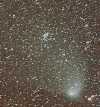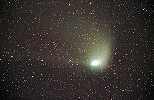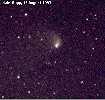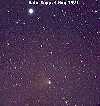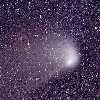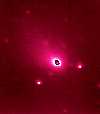 August 9, 1997
August 9, 1997
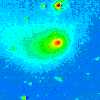 August 12, 1997
August 12, 1997
|
Observer: MS Robinson
Location:Discovery shuttle in orbit
Optics:7-inch Southwest Ultraviolet Imaging System (SWUIS).
Astronauts View Comet Hale-Bopp
NASA and the Southwest Research Institute, along with scientific collaborators
from JPL, APL, and the University of Maryland, developed an innovative
new wide-field ultraviolet (UV) imager to observe comet Hale-Bopp from
the Space Shuttle this August. The instrument is called the Southwest Ultraviolet
Imaging System, or SWUIS (pronounced like "swiss"). The primary objective
of the SWUIS Hale-Bopp Imaging experiment is to obtain image sequences
of Hale-Bopp to study its coma and tail morphology and response to solar
wind conditions during the scientifically-interesting, classical turn-off
phase as the comet moves outbound beyond 2 AU. Observations were done through
the only window on the spacecraft that does not have ultraviolet filtering.
To assist the observations, the shuttle's robotic arm was positioned to
shade the window from the Sun.
-
9 Aug 1997 (acq2-b.gif): SWUIS Hale-Bopp comet acquisition image
taken from Discovery. Computer enhanced versions of a portion of the visible+UV
acquisition sequence. Integration time of 83.3s.
-
12 Aug 1997 (acq4-b.gif): A false-color 40s integration of comet
Hale-Bopp obtained during the aquisition for Discovery's 3rd orbit of SWUIS
observations.
Please note that these are not final data products
and are built from a very small fraction of 250,000 useful data frames
collected so far.
SWUIS
Hale-Bopp STS-85 Imaging Mission
|
